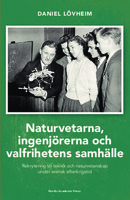Naturvetarna, ingenjörerna och valfrihetens samhälle: Rekrytering till teknik och naturvetenskap under svensk efterkrigstid
Abstract
"Scientists, engineers, and a free-choice society is a book about control, largely the governing of children and young people in Sweden and the efforts made to persuade them to choose careers—and identities—in science and technology in the period 1950–2000. It is very much part of an interdisciplinary research tradition in which perspectives taken from the history of science and education are combined with theories from the field of governmentality studies. The book begins by describing a new societal problem that confronted Sweden, like so many other Western countries, in the immediate post-war years, namely a lack of engineers and scientists. The period from the outbreak of the Second World War to the mid fifties saw a new appreciation for scientific research and its application in both the military and civilian sectors. With the reconstruction of Europe and the Marshall Plan at its height in the fifties, technology and science became gradually associated with rising industrial productivity and with economic growth in general.
By the sixties this had left national employment policy with some markedly pronounced objectives. By the end of the decade, it was obvious that the determination to increase student numbers in science and engineering ran contrary to other political ambitions, and did not sit well with the right of the individual to freedom of choice in education. The attempt to respect people’s autonomy while at the same time enabling more of them study these particular disciplines shaped a distinct set of strategies that made up the ‘positive exercise of power’—what might also be called liberal governing—in which the main idea was to encourage students to come to science and engineering of their own free will.
The book goes on to demonstrate how this strategy of governing through individual autonomy would result in a series of specific measures in the seventies and on, including changes to the curricula and teaching materials, which were matched by activities outside the traditional bounds of learning such as a travelling science shows, advertising campaigns, and the construction of science and technology centres. The book also spells out the sheer reach of this recruitment policy. Many leading figures in Sweden set out to encourage people to become scientists and engineers—these were voices heard not only from government quarters, but also from industry and special interest groups.
Scientists, engineers and a free-choice society does not set out to answer the question of how best to set about attracting young people into science and technology; rather, it is concerned with how that question has been answered by others, and what impact their responses have had on power relations between society and the individual, and indeed on the place of science and engineering
education in the present. Naturvetarna, ingenjörerna och valfrihetens samhälle handlar om styrning av framförallt barn och ungdomar i Sverige till att välja naturvetenskap och teknik som utbildning, yrke och identitet mellan åren 1950–2000. Ämnesmässigt befinner sig texten i en tvärvetenskaplig forskningstradition där perspektiv från vetenskapshistoria och utbildningshistoria används tillsammans med teoretisk inspiration från fältet governmentality studies. I boken beskrivs inledningsvis framväxten av en ny samhällelig problembild i Sverige och övriga västvärlden under tidig efterkrigstid, nämligen bristen på ingenjörer och naturvetare. Den period som sträckte sig från andra världskriget krigets utbrott till 1950-?talets mitt hade sett en ny värdering av vetenskaplig forskning och tillämpning, både från de militära och civila delarna av samhället. I samband med återuppbyggnaden av Europa och den pågående Marshallhjälpen sammankopplades teknik och naturvetenskap alltmer med ökad industriell produktivitet men också med ekonomisk tillväxt.
Ovanstående utveckling ledde under 1960-?talet till att rekryteringspolitiska målsättningar uttalades allt starkare. I slutet av decenniet blev det uppenbart att viljan att höja antalet studerande i teknik och naturvetenskap kom att kollidera med andra utbildningspolitiska ambitioner, framförallt den om individens rätt till ett fritt val av utbildning. I försöken att på samma gång respektera detta självbestämmande och samtidigt skapa fler studerande inom de ovan nämnda disciplinerna växte strategier fram i formen av ett slags ”positiv maktutövning” – vad som också kallas liberalt styre – där den bärande idén var att förmå elever att söka sig till naturvetenskap och teknik av sin egen fria vilja.
Boken ger fortsättningsvis prov på hur denna strategi att styra genom individens autonomi frambringade en rad olika specifika påverkanssåtgärder från 1970-?talet och framåt. Bland dessa återfinns förändrade kursplaner och läromedel, men också insatser utanför den traditionella läromiljön, såsom kringresande vetenskapsshower, reklamkampanjer och uppförandet av teknik-? och vetenskapscentra. Vad som också framträder i boken är rekryteringspolitikens bredd. Många aktörer i samhället verkade för fler naturvetare och ingenjörer – inte endast på myndighetsnivå utan även inom näringsliv och bland enskilda intresseorganisationer.
Naturvetarna, ingenjörerna och valfrihetens samhälle ger inga svar inte på hur fler ungdomar skall förmås bli intresserade av naturvetenskap och teknik. Snarare handlar boken om hur den frågan besvarats av andra och vilka konsekvenser detta har fått för uppkomsten av nya maktrelationer mellan samhälle och individ, men också för de naturvetenskapliga och tekniska utbildningarnas positioner i samtiden."
Keywords
freedom of choice; recruitment; vocational guidance; education policiesDOI
10.21525/kriterium.7ISBN
9789188168733OCN
1030816808Publisher
KriteriumPublication date and place
Gothenburg, Sweden, 2016Classification
History
Teaching of a specific subject
Political structure and processes
History of science
Technology, Engineering, Agriculture, Industrial processes


 Download
Download Web Shop
Web Shop